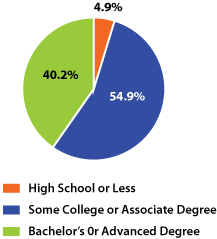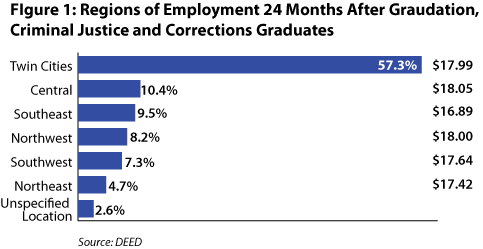by Chet Bodin
June 2016
Guards protect people, places, and things. Crossing Guards protect children going to school, Lifeguards protect children and adults participating in water activities, and Security Guards protect people and property in a variety of public and private places. While each of these types of Guards has an important role in safeguarding the public, several other occupations belong to the Protective Services occupation group and share guard-like responsibilities. These occupations include Corrections Officers and Jailers, Recreation Attendants, Game Wardens, Police and Sheriff Patrol Officers, and even some Receptionists. Because of the amount of available data, this article will focus on the occupations found in the Protective Services group.
| Occupation | Functions | Degree Required | Education Attainment of workers in occupation (MN) |
|---|---|---|---|
| Correctional Officers and Jailers | Guard inmates in penal or rehabilitative institutions in accordance with established regulations and procedures. May guard prisoners in transit between jail, courtroom, prison, or other point. Includes deputy sheriffs and police who spend the majority of their time guarding prisoners in correctional institutions. | High School Diploma or Equivalent Professional Certification
|
 |
| Police and Sheriff Patrol Officer | Maintain order and protect life and property by enforcing local, tribal, State, or Federal laws and ordinances. Perform a combination of the following duties: patrol a specific area; direct traffic; issue traffic summonses; investigate accidents; apprehend and arrest suspects, or serve legal processes of courts. | High school Diploma or Equivalent Professional Certification
|
 |
| Source: 2016 CAREERwise, Minnesota State Colleges and Universities; U.S. Census Bureau's American Community Survey | |||
Over 42,000 Minnesotans work in Protective Service Occupations. While over half are employed in the Seven County Metro Area, higher wages, for a variety of reasons, are often found in Greater Minnesota. According to DEED's 2016 Occupation and Employment Statistics (OES), Protective Service workers earn a higher median wage in Northwest, Central, and Southeast Minnesota than in the Metro Area. Through 2022 Protective Service jobs are expected to grow fastest in Central Minnesota, but Northwest, Southeast, and the Metro Area also have positive growth projections.
| 2016 Minnesota Occupation and Employment Statistics, Protective Services Occupations | |||
|---|---|---|---|
| Geography | OES Employment | Median Wage | Projections 2012-2022 |
| Northwest Minnesota | 4,980 | $20.26 | 5.1% |
| Northeast Minnesota | 2,800 | $18.47 | -0.1% |
| Central Minnesota | 2,340 | $23.46 | 7.4% |
| Seven County Metro | 25,100 | $19.05 | 5.0% |
| Southwest Minnesota | 3,210 | $18.16 | -1.6% |
| Southeast Minnesota | 4,010 | $21.41 | 1.9% |
| Source: 2016 DEED Occupation and Employment Statistics | |||
Although most Protective Service occupations require only a high school education, over 75 percent of those who graduated in 2013 with a post-secondary award in criminal justice were gainfully employed in 2015. Workers with one-year certificates were making more per hour in 2015 ($19.61) than graduates with Associate's ($16.64) and Bachelor's degrees ($18.47). Certificate holders might also have Associate or Bachelor's degrees earned in a prior year, and this may explain the higher wage earned by Certificate Holders. As with all Protective Service workers, over 50 percent of recent graduates are working in the Seven County Metro Area (see Figure 1).

Protective Service occupational opportunities are available throughout Minnesota. Relatively low education requirements for employment allow Protective Service workers to carve out a career path in many ways. There are opportunities for employment in multiple industries and in various jobs with different levels of responsibility. Upward mobility in these Protective Service occupations will likely require professional certification training and work experience which is readily available for current Protective Service professionals and prospective job seekers.
| Minnesota Statewide Graduate Employment Outcomes, Criminal Justice and Corrections Programs | |||
|---|---|---|---|
| Post-Secondary Award | 2013 Graduates | Two years after Graduating | |
| Percent Earning Wages in MN | Median Hourly Wage | ||
| Certificates (less than Bachelor's Degrees) | 273 | 81.3% | $19.61 |
| Associate's Degrees | 990 | 78.4% | $16.64 |
| Bachelor's Degrees | 853 | 75.3% | $18.47 |
| Source: DEED Graduate Employment Outcomes | |||